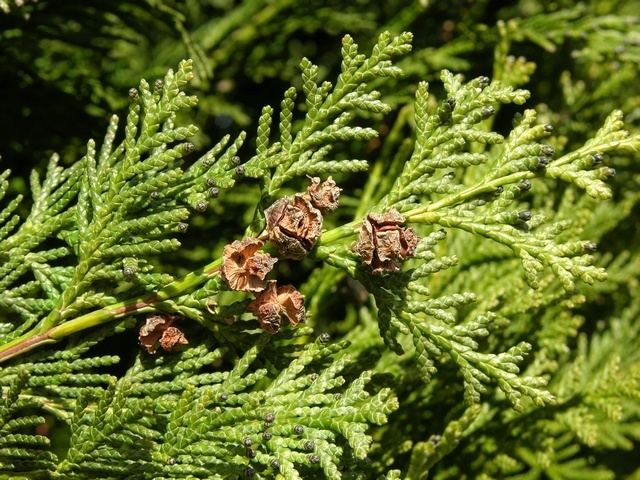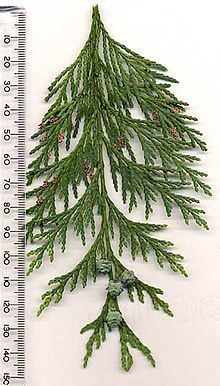Higher classification False cypress | Division Pinophyta Rank Species | |
Similar False cypress, Conifers, Chamaecyparis pisifera, Cupressus, Arborvitae | ||
Chamaecyparis lawsoniana
Chamaecyparis lawsoniana, known as Port Orford cedar or Lawson cypress, is a species of conifer in the genus Chamaecyparis, family Cupressaceae. It is native to Oregon and northwestern California, and grows from sea level up to 1,500 m (4,900 ft) in the valleys of the Klamath Mountains, often along streams.
Contents
- Chamaecyparis lawsoniana
- Port orford cedar chamaecyparis lawsoniana identification tips
- Description
- History and names
- Prehistory
- Wood
- Horticulture
- Disease
- References

Port orford cedar chamaecyparis lawsoniana identification tips
Description

It is a large evergreen tree, maturing up to 197 ft (60 m) tall or more, with trunks 4–7 ft (1.2–2 m) in diameter, with feathery foliage in flat sprays, usually somewhat glaucous (i.e. blue-green) in color. The leaves are scale-like, 1⁄8–3⁄16 inch (3–5 mm) long, with narrow white markings on the underside, and produced on somewhat flattened shoots. The foliage gives off a rather pungent scent, not unlike parsley. The seed cones are globose, 9⁄32–9⁄16 inch (7–14 mm) diameter, with 6-10 scales, green at first, maturing brown in early fall, 6–8 months after pollination. The male cones are 1⁄8–5⁄32 inch (3–4 mm) long, dark red, turning brown after pollen release in early spring. The bark is reddish-brown, and fibrous to scaly in vertical strips.
History and names

It was first discovered (by Euro-Americans) near Port Orford in Oregon and introduced into cultivation in 1854, by collectors working for the Lawson & Son nursery in Edinburgh, Scotland, after whom it was named as Lawson Cypress by the describing botanist Andrew Murray. The USDA officially calls it by the name Port Orford cedar, as do most people in its native area, but some botanists prefer to use the name Lawson cypress (or in very rare instances Port Orford cypress) instead. The name "Lawson's cypress" is widely used in horticulture.
Prehistory
The extinct Eocene species Chamaecyparis eureka, known from fossils found on Axel Heiberg Island in Canada, is noted to be very similar to Chamaecyparis pisifera and C. lawsoniana.
Wood
The wood is light yet has great strength and rot resistance, and is particularly highly valued in east Asia, with large amounts being exported to Japan where it is in high demand for making coffins, and for shrines and temples. Its lumber is also known for its highly fragrant ginger aroma. Due to the straightness of its grain, it is also one of the preferred woods for the manufacture of arrow shafts. It is also considered an acceptable, though not ideal, wood for construction of aircraft.
However, it is considered more than acceptable for use in stringed instruments. Its fine grain, good strength and tonal quality are highly regarded for soundboards in guitar making.
Horticulture
Several hundred named cultivars of varying crown shape, growth rates and foliage colour have been selected for garden planting. It thrives best in well-drained but moist soils. The following cultivars have gained the Royal Horticultural Society's Award of Garden Merit:-
Disease
In the wild, the species is seriously threatened by a root disease caused by the introduced oomycete pathogen, Phytophthora lateralis. This disease is also a problem for horticultural plantings in some parts of North America. The tree is sometimes killed, though less often, by other species of Phytophthora.
Phytophthora lateralis infection begins when mycelium, from a germinated spore, invade the roots. The infection then spreads through the inner bark and cambium around the base of the tree. Spread up the trunk is generally limited. Infected tissue dies and effectively girdles the tree. Large trees are more likely to be infected than small trees due to larger root areas (although all trees at the edges of infected streams will eventually succumb). However, large trees can often live with the infections for a longer duration (up to several years).
C. lawsoniana in streamside populations are highly susceptible to Phytophthora lateralis infection. However, the rate of Phytophthora spread through populations in dry upland areas appears to be slow. Phytophthora lateralis spreads through water via mobile spores (zoospores). The fungus also produces resting spores (chlamydospores) that can persist in soil for a long period of time. New infections generally begin when soil is transferred from an infected population to a non-infected population via human or animal movement. After initial infection in streamside populations, secondary spread via zoospores quickly infects all downstream individuals.
Human facilitated spread is thought to be responsible for most new, and all long-distance, infections. Soil on vehicle tires, especially logging trucks and other off road vehicles, is considered the most pressing problem due to the volume of soil that can be carried and the traffic rate in and between susceptible areas. Spread on boots and mountain bike tires has also been suggested and probably contributes to new infections locally. Animal facilitated spread is thought to occur, but is localized.
The Bureau of Land Management (BLM) and United States Forest Service (USFS) attempt to prevent Phytophthora spread through road closures, monitoring, research and education. Research has focused on determining the dynamics and mechanisms of spread, as well as attempts to breed resistant trees. The solution against Phytophtera is known as Mancozeb also commercially known as Dithane (C)
